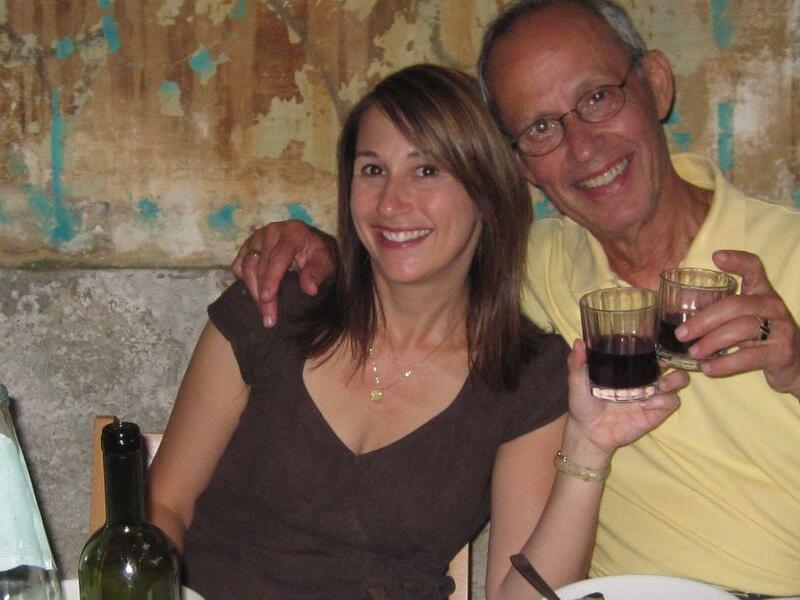Physical Address
304 North Cardinal St.
Dorchester Center, MA 02124
Physical Address
304 North Cardinal St.
Dorchester Center, MA 02124

The author is pictured with her dad in Rome, Italy.
“I saw Dad’s junk today. Good times!”
“You just made me spit out my coffee,” my sister texted back with a laughing-crying emoji.
The mental image of Lisa doing a spit take at work was a small consolation for seeing my dad in this diminished state. No longer able to navigate a trip to the bathroom on his own, he’d ended up on the tile floor at 3 a.m. with his pajama pants bunched around his knees. He was too weak to get himself back to bed.
Dad had entered hospice a few weeks before this episode because he was dying from a rare bone marrow cancer. He had only six weeks to live, and I’d flown across the country to be his in-home hospice caregiver. Lisa eventually joined me in Dad’s house as co-caregiver. She saw his junk, too.
Along with confirming that I would have made a lousy nurse, the experience raised a nagging question that would haunt me in the following years: With no kids of my own, who will take care of me when my time comes?
When I first arrived in Michigan to help my dad, I didn’t believe he would die in a little over a month. The man seemed fine, puttering around the house on his own and laughing with family during visits. There really wasn’t much for me to do, other than to make sure he took his meds each morning and cook something for dinner before “Jeopardy!” came on. But just as hospice predicted, Dad declined a little each week. He became fatigued and unsteady on his feet, requiring a walker and eating less and less of the food I prepared.
His pain increased to the point where morphine was no longer up to the task, and the hospice nurse — who came to Dad’s house just once a week for a quick check-in — asked me if I thought it was time for a fentanyl patch.
“I’m a magazine editor,” I thought. “How the hell should I know?”
One day, while I was pushing Dad around the living room in his wheelchair, he murmured, almost under his breath, “I want to die.” I wanted that for him, too.
Six years after my 74-year-old dad succumbed to his illness, I discovered that my mom had vascular dementia, and that she was already years into the disease. The realization blindsided me during an otherwise normal phone chat.
The author’s dad sits with her dog, Sophie.
Out of the blue, Mom said she wanted to tell me a secret: Someone named Lisa had been calling her, and she had no idea who this person was. Mom had been playing along during their conversations because she didn’t want to offend the nice woman on the phone.
With a shaky voice I explained that Lisa was her firstborn daughter. Mom sounded surprised, exclaiming, “Really!” as if I’d told her that the neighborhood squirrels had just flown a nut-shaped rocket to the moon.
With me in California, Lisa in Michigan and Mom living alone in South Carolina — she never remarried after divorcing my dad decades earlier — the situation required a whole other level of caregiving. The excruciating, long-distance kind.
Two years of hell followed Mom’s late diagnosis. Managing her care became a second job, made even more difficult by the fact that she had no financial resources and I had to raid my retirement savings to help pay for it.
As Mom’s dementia escalated, she sometimes called me several times a day in agitation and confusion, telling me about a mysterious and frightening man who’d somehow gotten into her apartment and was moving things around. Sometimes, she said, he left items there that were not hers.
“The man,” as she called him, did not exist; like many people with dementia, my mom suffered from hallucinations and delusions.
We kept Mom in her apartment as long as possible, as she would have wanted, but in-home caregivers proved scarce and unreliable in her small town. She eventually got to the point of needing 24-hour care, costing almost $600 a day, and the agency we hired 50 miles away had only one person available in Mom’s area.
One weekend, when her regular caregiver couldn’t come, a neighbor called to tell me that the agency had left Mom to fend for herself for the past two days, and that paramedics were on the scene. Lisa and I started making plans to get her out of there the next day.
Mom was far better off in assisted living, though she wasn’t always happy about her new accommodations. A fiercely private person all her life, she didn’t understand why staff members kept coming into her room uninvited, pushing aside the assorted items she’d used to barricade the door and insisting she go down to the dining room for meals.
I wouldn’t have wanted to come out of my room, either; the facility was dated and depressing — but it was the best that Lisa and I could manage. At 78 years old, Mom was younger than most of the other residents there and among only a few who could walk around the place unassisted. Until she started falling.
The author, left, is seen with her mom “in the big-hair ’80s.”
In the span of a couple of months, she broke both hips and fractured her shoulder, confining her to a wheelchair. Immobility and subpar care led to a gruesome pressure wound on her foot that her depleted, 65-pound body could never heal.
What kind of society insists on keeping a person alive in that condition? In her predementia days, my mom — always quick with a joke or a biting comment — would have said, “Just get a gun and shoot me.”
When Mom died last year, the day before Mother’s Day, I cried with both sorrow at her unfair, horrible ending and with relief that it was finally over. Yet, the nagging question remained about my own uncertain future.
Caring for my parents, I’d become increasingly obsessed with the idea that I was doomed to spend my final years in a dreary care facility surrounded by strangers, just waiting for the end to come. While I realize that having kids does not guarantee that they will someday take care of you, I also know that there is a zero percent chance that your nonexistent offspring will do it. This thought filled me with a crushing sense of fear and foreboding about getting older. That is, until I resolved to plan my own death.
The idea surfaced gradually from some hidden cranny of my subconscious, reminding me of my favorite movie since high school: “Harold and Maude.” In this 1971 dark comedy starring the great Ruth Gordon, a morbid young man falls in love with a free-spirited septuagenarian. In the film’s climax, Maude carries out a long-held plan to end her life on her 80th birthday, on her own unconventional terms. Why shouldn’t I be like Maude?
At first, I thought my death would have to be a DIY affair. I knew that if I wasn’t going to die from an incurable illness within six months, or if I had dementia, that would disqualify me from the “medical aid in dying” options offered by a growing number of states. Though well intentioned, these programs are so mired in bureaucracy and restrictions that even patients who qualify often die while waiting for approvals.
Advocacy groups like Death With Dignity are working to streamline and expand end-of-life options across the country, but the wheels turn slowly. And if you have dementia, like my mom, or just feel like you’ve had a good run after 90 years on the planet? No soup for you!
Determining how to bring about a dignified, pain-free ending without medical help was a daunting prospect, so I began workshopping the idea — only half-joking — with friends. Would my college pal, an anesthesiologist, be willing to risk prison time to help me out? What kind of bribe money would I need to convince a veterinarian to do the deed?
Then, in the months after my mom’s death, an acquaintance recommended Amy Bloom’s “In Love: A Memoir of Love and Loss,” a heartbreaking book that chronicles the author’s journey to Zurich to witness the assisted death of her husband, who’d been diagnosed with early Alzheimer’s.
A photo shows the author’s mom.
I was astonished to learn that, in Switzerland, assisted death has been legal for over 80 years. It’s lawful as long as the person is of sound mind and is able to self-administer the life-ending pharmaceutical cocktail. Dignitas, a nonprofit that Bloom writes about in her memoir, requires that the individual have an illness that will eventually lead to death — including dementia — or be living with an unbearable disability. Another organization, Exit International, also lays out options for older adults and couples who want to go together.
Exit’s founder, Philip Nitschke, even invented a futuristic, 3D-printable pod designed to deliver a euphoric, painless death without the need for assistance. The third-generation prototype is still in the testing phase, but in the meantime, Nitschke’s nonprofit offers an array of “final exit” resources, including guides to life-ending drugs and assisted death programs in Switzerland.
Though some may find it macabre, learning about organizations like Dignitas and Exit International has brought me an incredible sense of peace and comfort in knowing that I have options. Instead of feeling overwhelmed with constant dread of getting older, I can focus on living.
Still, I can’t help thinking about what will happen if I can’t make it to Zurich when I feel like it’s time to sign off. Wouldn’t it be wonderful for Swiss-style options to be available here in the United States, and affordable to all? Then, those who decide to opt out could do so on their home turf surrounded by loved ones, without adding physical or financial burdens to the process.
I realize that not everyone would welcome this. However, I believe that, like abortion, end-of-life decisions are a personal choice that should be made by the individual. If you don’t believe in it, don’t do it. And if the Swiss can avoid the so-called slippery slope for 80-plus years through tight regulation and documentation, the U.S. can figure it out, too.
My husband of 22 years, my beloved companion on life’s journey, says he isn’t quite ready to sign up for the BOGO assisted-death special — a final date night, if you will — but a lot can happen in the next couple of decades. We could both expire well before the need for such a plan arises, or I could simply change my mind. It’s enough for me to know that I need not be forced to keep living beyond my self-determined expiration date — even if I have to travel all the way to Switzerland to pull the plug. I can do it Maude’s way.
Tina Caputo is a multimedia journalist and writer based in California. Her work has appeared in McSweeney’s, The Belladonna Comedy, and too many wine and lifestyle publications to mention.
]}



